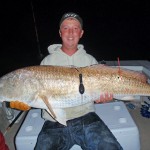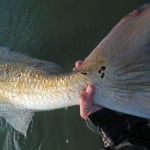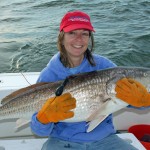I received a message from Kayak Kevin that he thought that he had recaptured one of our red drum. After some discussion, I understood that he was referring to one of the red drum that we had place satellite pop-up tags in several years ago. Indeed, the photo of the “tag” looked exactly like the anchoring system that we had used. Dr. Andrij Horodysky confirmed that it was one of the anchors he had made, right down to the shrink tubing. At the time, he was still a graduate student of Dr. John Graves at the Virginia Institute of Marine Science.
Dr. Graves and his students had done a number of studies of pelagic fish with satellite tagging. What had not been done, due to the tag’s large size, were studies of inshore fish. There were some concerns about catch and release mortality of large striped bass being caught during the wintertime at the mouth of the Chesapeake Bay after the season was closed. The practice was legal but Virginia’s fishery managers wanted to know what harm was being done. A newer generation of tag was smaller, making it a possible answer to the question. We took Dr. Graves and Andrij out in the Healthy Grin one very cold winter to find out. It turned out that the tags worked great and there were no mortalities of the caught, tagged, and released striped bass.
This opened up the possibility for the study of other inshore fish with pop-up satellite tags. Dr. Graves gave me a refurbished tag and asked me to place it in a red drum. In the spring of 2008, my wife, Tricia, and I took the tag out to shoals and she caught a big red drum. The fish was deep-hooked and we just cut the leader and left the hook in the fish. We placed the relatively large pop-up tag and a Virginia Game Fish Tag into the fish, held it up for photos, and then released the fish. On schedule, 30 days later, the tag released from the fish and transmitted its data. The fish had survived the experience and a lot of data was gathered.
This led to a red drum tagging study the following year. We went out in Charles Southall’s boat, Special Kate, and tagged 15 red drum during a weekend in May. Both satellite tags and Virginia Game Fish tags were place in each fish. The PSAT tags were scheduled to release at various times with 1/3 releasing at 30 days, 1/3 at 90 days, and 1/3 at 180 days. Some very interesting water column usage and migration patterns were shown and again, there were no post-release mortalities.
Back to 2015, the fish Kayak Kevin caught was indeed one of the fish that we tagged that weekend in 2009. From his photographs and the photographs we took of the fish during the tagging study, we have even identified which one. Chris Boyce caught the fish in 2009. It was about 46 inches long at that time. Almost exactly to the day, 6 years later, and almost in the exact same location, Kayak Kevin recaptured the fish. The fish was now 52 inches long. Kevin snipped off the tag anchor so it does not have to swim around with that anymore. The Virginia Game Fish Tag was no longer on the fish. The steel-dart anchor had failed while the surgical-grade nylon PSAT anchor had held, even with the much greater drag created by the larger tag. This could be one reason for the very low tag return rate for large red drum. These same steel-dart tags seem to work well in cobia but they may not be staying in the large drum as well.
For more information on the red drum (and other) research, Dr. John Graves can be reached at [email protected] . Dr. Andrij Horodysky can be reached at: [email protected] . More about Kayak Kevin (yes, that is what he is known as): www.kayakkevin.com
An article on these studies which was first published in the IGFA’s International Angler: https://healthygrinsportfishing.com/?page_id=280





